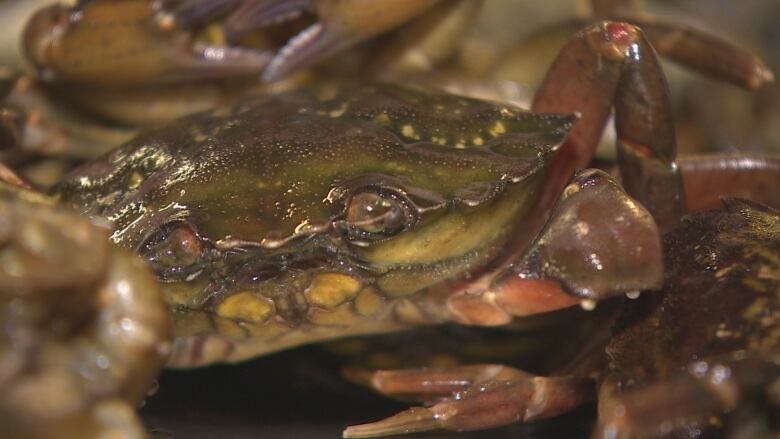'They were born ferocious': Hybrid green crab species threatens N.L. lobster
Invasive critters also eat clams, scallops and even each other

They're fearless. They can live for weeks out of the water. They will eat anything, even each other.
"They were born ferocious," said Cynthia McKenzie, a scientist with the Department of Fisheries and Oceansbased in St. John's.
McKenzie is one of a group of researchers who haveidentified a species of green crab that is ravaging parts of Newfoundland's south coast.
There are little to no predators here and so they've just exploded.- Cynthia McKenzie, scientist, DFO
The species combines genes froma population originating in the eastern United States with one from northern Europe.
"So what we have is a population that ishybridized, mixed, that is very cold-tolerant," McKenzie said. "And, of course, there are little to no predators here, and so they've just exploded."
Conditions in thefrigid Newfoundland waters have provided a perfect environment for this newly identified green crab to thrive.
First found a decade ago
Fishermen inPlacentiaBay, on the southeast coast,first noticed green crab in 2007. They probably arrived through shipping from northern Europe through the Halifax area, McKenzie said. Now the creatures have spread throughout the bay and are beginning to take up residence in nearby Fortune Bay, home to a large lobster fishery.
Lobster catches were already in decline there, but it is almost certain that the green crab are having an impact, she said.
Lobster fishermen agree.

"When a lobster spawns the green crab is there to eat it," said Clarence Marsh. "I think the green crab got a big effect on the lobsters, and that's why there's none here in this bay now."
The green crab are "numerous," said Marsh, and they don't stop at eating lobster. He has also found tiny green crabs inside scallop shells.
"I get hundreds and hundreds of shells with the fish gone out of them. There's no scallop here now like there used to be," Marsh said.
Unlike the much larger snow crab, viable markets for green crab do not exist. The largest of the creatures measure only about 10 centimetres acrossand containvery little meat.
"What they do with clams and scallops is they use their claws to snip the edges of the shell and then they stick their claws in to pull the meat out," said McKenzie.

When NicciZargarpour, a graduate student fromMemorial University's Marine Institute, began studying green crab she said she noticed the rocks on the shore were "crawling" with the "thumbnail-sized" shellfish.
Each time she has gone back to the field, Zargarpor says, the numberof green crabs has exploded. "So the threat of the spread is real," she said.
Preventing further spread
Having seen the ecological harm green crab have inflicted inPlacentiaBay, McKenzie's goal is to prevent a widespread invasion into Fortune Bay.
"They can actually be transported in gear or in boats from one place to another without anyone realizing it because people think a crab will die out of [the] water," saidMacKenzie. "Not these guys."
When the lobster spawns, the green crab is there to eat it.- Clarence Marsh, fisherman
Marsh says fisherman could get the green crab under control if the government issuedlicencesto catch them.
"You'd get boatloads," said Marsh.
McKenzie agrees that could helpprevent further spread; eventually, local predators will do their part to reduce the green crab infestation.
In their nativeEuropean environment, green crab are kept in check by shorebirds and other species, said McKenzie.
"Once the seabirds figure it out and the lobster and the rock crab and various other things, I`m hoping that that will have an impact."












_(720p).jpg)


 OFFICIAL HD MUSIC VIDEO.jpg)
.jpg)



























































































